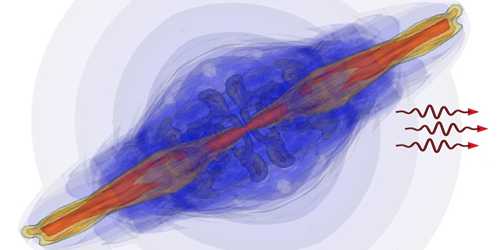Off-Axis Jets from Neutron Star Merger
For decades, astronomers have debated the origin of short gamma-ray bursts (GRBs) coming from distant galaxies. The mystery appeared to be solved when researchers saw gamma rays accompanying the neutron star merger detected in 2017. However, the gamma-ray signal was unusually faint for a short GRB, and the afterglow’s brightness at frequencies ranging from radio to x rays unexpectedly increased in the weeks following the merger. Using computer models, Davide Lazzati, of Oregon State University in Corvallis, and colleagues show that the 2017 observation is consistent with a canonical short GRB viewed at an oblique angle.
When neutron stars collide, debris is funneled into narrow jets along the pair’s rotation axis and blasted away at relativistic speeds. Lazzati and collaborators ran hydrodynamic simulations of these jets to calculate how the light emerging from the jets evolves over time, varying parameters such as the density of the surrounding gas and the viewing angle. They found that a jet viewed off axis by about 30° best matches all of the observations. This jet has a narrow, relativistic core surrounded by a slower moving spray of debris. According to the simulations, the reduced luminosity is due to the off-axis viewing angle, while the postmerger increase of the radio-to-x-ray flux arose from different parts of the jet coming into view at different times.
While these results suggest that neutron star mergers can be the origin of short GRBs, more detections will help strengthen this conclusion. The team estimates that one out of every 20 mergers will point its jets right at Earth, giving us an unimpeded view of a more typical short GRB.
This research is published in Physical Review Letters.
–Christopher Crockett
Christopher Crockett is a freelance writer based in Montgomery, Alabama.





